Exploring Our World: People, Places, and CulturesChapter 4:
Physical Geography of the United States and CanadaWeb Activity Lesson PlansIntroduction
In this chapter, students studied the various landforms that make up the physical geography of the United States and Canada. The Piedmont, a region of low rolling hills and farmland, is a transitional landform between the Atlantic coastal plain and the Appalachian Mountains. Extending nearly 700 miles from New Jersey to Alabama, the Piedmont has been the setting for many historical events since the colonial period. Students will access a National Park Service Web site to read about continuing efforts to preserve the historical character and scenic beauty of a portion of this unique American region. Lesson Description
Students will visit a National Park Service Web site to learn about Virginia’s Piedmont region. After reading about efforts to preserve portions of the region, students will answer questions about the Piedmont. Instructional Objectives
- The learner will be able to describe why the Virginia Piedmont is considered unique.
- The learner will be able to explain why the Virginia Piedmont is being lost.
- The learner will be able to explain how some groups are trying to preserve the Virginia Piedmont.
Student Web Activity Answers
- The Virginia Piedmont is made up of historic sites and scenic land.
- Some of the Piedmont’s sites are centuries old.
- Increasing urban growth and development
- Various groups, including the National Register of Historic Places, are trying to raise public awareness, promote “smart growth,” and help communities document historical/cultural sites.
 | 




